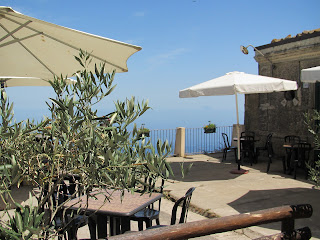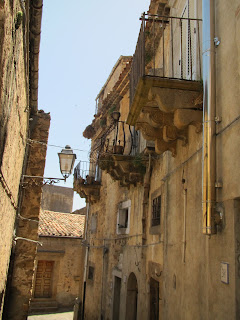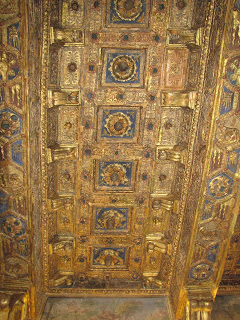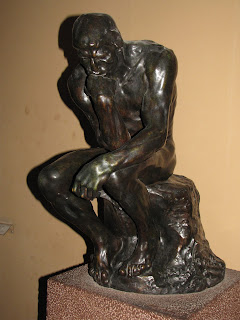We visited many beautiful places on this trip, from the
French Riviera to the Amalfi Coast, but I was most looking forward to visiting
Sicily and of course, Tusa, my family's home. Sicily is a volcanic island, with
mountains rising abruptly from the seaside. The island's creator, Mt Etna, is still
quite active (latest). Although it's flag is vaguely disturbing, every town and
village, seaside or mountain, looks like a postcard. We spent the most time in Cefalu, Tusa and Taormina.
(note: click on any image for a full-size version)
(note: click on any image for a full-size version)
Due to its location in the central Mediterranean, it has
been occupied (and invaded) for thousands of years with Greek influences most
visible. Fishing, herding, olive groves and citrus remain important today,
though tourism likely brings in more euros. The food? I had what may be the
best dish I've ever eaten in my life - "pasta con sarde". An archetypal dish made with anchovies,
fennel, olives, onions, pine nuts, raisins, saffron and and olive oil, covered in toasted bread crumbs ("per
favore, una bottiglia di nero d'avola
... grazie mille!").
I live in an historic American city and marvel at local
sites and churches dating back to the 17th century, but am humbled to learn
Tusa (originally known as the Greek town of Halaesa) was settled in the year
403 BCE and has Greek ruins from those days. Tusa has a geographic split personality - Castel di Tusa (aka Marina
di Tusa) is on the coast while Tusa Montagna lies 9 serpentine kilometers south
and a little over 600 meters higher.
 This photo (left, stock) shows the lower, seaside portion of the town with a view of my family's mountain home looming in the upper left. The 9km drive up from the coast was great fun for me (though for Geri, not so much) as switchback and blind turns competed with the mountain and Mediterranean views.
This photo (left, stock) shows the lower, seaside portion of the town with a view of my family's mountain home looming in the upper left. The 9km drive up from the coast was great fun for me (though for Geri, not so much) as switchback and blind turns competed with the mountain and Mediterranean views.
My cousin Rosalie had drawn me a map to get us started when we reached Tusa Montagna, but we didn't need it. As we drove along Via Roma looking for Via Murorotto, I heard someone calling "Anthony! Anthony!". It was my Aunt Rosalia's friend Sebastian, who immediately recognized us (?). The Aliberti family, Orazio (deceased), Rosalia and Sara were good friends of both the Caruso and DeMarco families and were our hosts and guides for the day.
After wandering most of the town, Geri and I were treated to a five-course lunch, during which I was treated like a returning prince. Geri was very patient, nodding and smiling at all the right moments while the rest of us talked non-stop in Sicilian (Thank you SO much, cara). Fortunately, Geri also reminded me to shut up long enough to eat, since the next course would not be served until il principe was finished ...
Left, Sebastian and his wife Anna. Right, Zia Rosalia (front) and her sister Anna.
After wandering most of the town, Geri and I were treated to a five-course lunch, during which I was treated like a returning prince. Geri was very patient, nodding and smiling at all the right moments while the rest of us talked non-stop in Sicilian (Thank you SO much, cara). Fortunately, Geri also reminded me to shut up long enough to eat, since the next course would not be served until il principe was finished ...
Left, Sebastian and his wife Anna. Right, Zia Rosalia (front) and her sister Anna.
We actually started at Rosalia's house on Via Matteoti where we looked at photos and caught our breath. The last photo below is Zia Rosalia holding a photo of ... wait for it ... Guglielmo Marconi! Yes, THAT Marconi. Apparently, Rosalia's mother contributed money to his efforts and she also has a signed letter from him.
Below are some views of the DeMarco home where my mother and her family lived. It's on Via San Giuseppe and as I learned, this Via was one of the older and more important streets in town as evidenced by it's having it's own local church, Chiesa San Giuseppe (directly across the street). BTW, no one was home.
Below right, the Demarco's neighbors, the Perrone family and the Sicilian home of my now US cousin Rosalie.
Next, the Caruso home (left) where my father, his 5 siblings and parents lived. Right is the home of my father's brother, Antonio, whose son Giovanni was our host and tour guide in Rome. Giovanni still owns that home and spends much of the summer there with his mother, my Zia Enza.
My father had many talents - he was a excellent tailor (with a sartorial degree from Torino), a barber, and a musician. He even owned a small olive grove and bottled his harvest for local sale every year.
On the left, was his tailoring shopfront when he lived in Tusa.
My parents were married in Tusa's main church, the Chiesa Madre, below.
Below right - The newlyweds moved into this house where they lived before coming to America.



"Mamma, son tanto felice
perché ritorno da te.
La mia canzone ti dice
ch'è il più bel sogno per me!"





























































